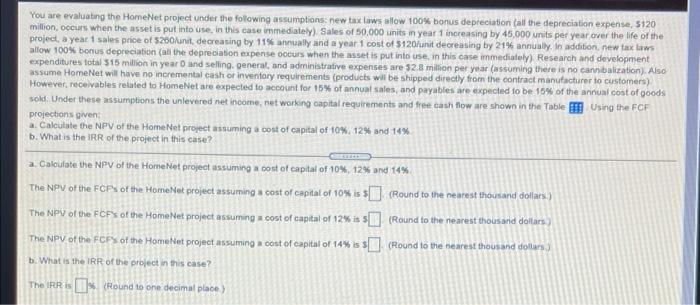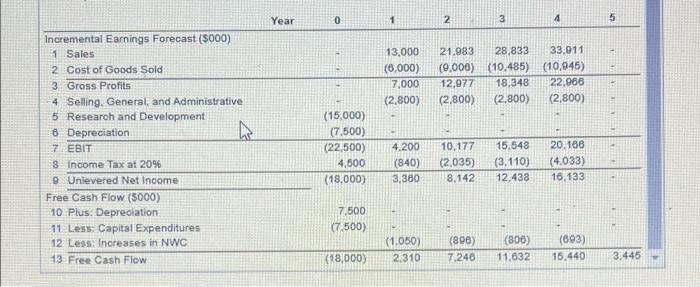You are evaluating the HomeNet project under the following assumptions: new tax laws allow 100% bonus depreciation (all the depreciation expense, 5120 million, occurs when the asset is put into use, in this case immediately). Sales of 50.000 units in year 1 increasing by 45,000 units per year over the life of the project, a year 1 sales price of 200/unit decreasing by 11% annually and a year 1 cost of 3120 unit decreasing by 21% annually. In addition, new tax laws allow 100% bonus depreciation (all the depreciation expense occurs when the asset is put into use, in this case immediately) Research and development expenditures total 315 million in year and selling general, and administrative expenses are 32.8 million per year (assuming there is no cannibalization). Also assume HomeNet will have no incremental cash or inventory requirements (products will be shipped directly from the contract manufacturer to customers) However, receivables related to HomeNet are expected to account for 15% of annual sales and payables are expected to be 10% of the annual cost of goods sold. Under these assumptions the unlevered net income, net working capital requirements and free cash flow are shown in the Table Using the FCF projections given 2. Calculate the NPV of the Home Net project assuming a cost of capital of 10%. 12% and 14% b. What is the IRR of the project in this case? a. Calculate the NPV of the Home Net project assuming a cost of capital of 10%, 12% and 14% The NPV of the FCPs of the HomeNet project assuming a cost of capital of 10% is $(Round to the nearest thousand dollars.) The NPV of the FCF's of the HomeNet project assuming a cost of capital of 12% is 5 (Round to the nearest thousand dollars) The NPV of the FCF% of the HomeNet project assuming a cost of capital of 14% is (Round to the nearest thousand dollars b. What is the IRR of the project in this case? The IRR is I (Round to one decimal place) - Free cash flow table Year 0 1 2 3 4 5 5 - 45 11% 2196 50 200 120 95 231.40 04.80 140 205.05 74.89 185 183.30 59.16 HomeNet Units Sales (000s) Sales Price (S/unit) Cost of Goods Sold ($/unit) Operating Expenses (5000s) Hardware & Software Develop Marketing & Technical Support Capital Expenditures Lab Equipment Depreciation Corporate Tax Rate (15,000) (2.800) (2,800) (2.800) (2,800) (7,500) 100% 20% 20% 20% 20% 20% Year 0 1 2 3 4 5 13,000 (6,000) 7.000 (2.800) 21.983 28,833 33,011 (0.006) (10.485) (10.045) 12,977 18,348 22,966 (2.800) (2.800) (2.800) Incremental Earnings Forecast (5000) 1 Sales 2 Cost of Goods Sold 3 Gross Profits 4 Selling. General and Administrative 5 Research and Development 8 Depreciation IN 7 EBIT 8 Income Tax at 20% Unlevered Net Income Free Cash Flow (5000) 10 Plus: Depreciation 11 Less: Capital Expenditures 12 Less Increases in NWO 13 Free Cash Flow (15000) (7.500) (22,500) 4,500 (18,000) 4.200 (840) 3.380 10.177 (2.035) 8.142 15.548 (3.110) 12.438 20,168 (4.033) 16,133 7,500 (7.500) (1.050) 2.310 (898) 7,240 (806) 11.632 (693) 15.440 (18,000) 3.445









